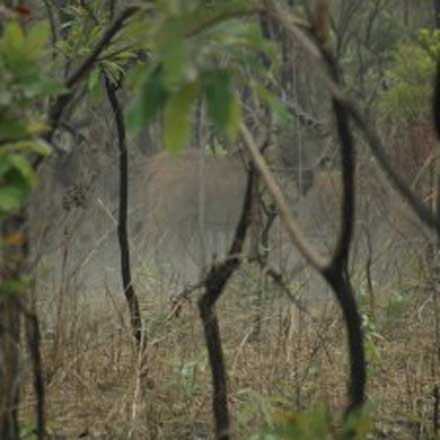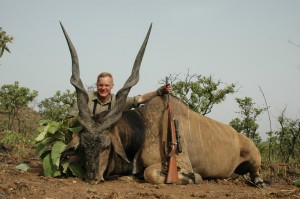
At the peak of the mid-afternoon heat, we took a break in the shade and drank some water. About six that morning, we’d picked up the tracks where we left them the night before. By now, I’d lost track of how many times we’d hit the herd, failed to get a shot, and had watched them break into their ground eating trot, vanishing in a cloud of dust. We were in northern Cameroon, and these were Central African giant eland, Lord Derby’s eland.
I probably shouldn’t have said that we had failed to get a shot. It would be more correct to say that we had refused to take a shot. There were about 70 eland in the herd and at least four mature bulls. Several times through that long, hot day, we had gotten the drop on one or another of the bulls; we had him dead to rights. Mind you, nobody passes a mature giant eland bull. But, this was a special situation. The evening before, after a nice bit of tracking, we were just closing on the herd when the wind swirled and caught us from behind. We hadn’t yet seen the herd, but now we heard them stampeding in front of us, as noisy as a herd of buffalo in motion.
In an incredibly intelligent move, PH Guav Johnson led us to the right at a dead run up to the top of a nearby hill. In front of us was a big burn, and at something approaching a half mile, we could look down on the entire herd. There were three decent bulls, fully mature with the black winter throat collar of the giant eland male. Ah, but there was one monster, a giant in a race of giants, with thick horns towering above the lesser bulls. Over the course of four hunts for giant eland, I have tracked many herds. Some of them I never saw at all, and I am certain this was the first herd I ever tracked having seen them all and knowing with certainty what was there.
It was early in the hunt, and we weren’t pressured, so we had decided on an all-or-nothing effort for this mighty bull. We had glimpsed him in the press of brown cows two or three times, so we knew he had stayed with them. Armed with this knowledge, we had passed easy shots at his fellows, and we’d continued to track, each time the herd growing spookier as a long, hot day grew longer and hotter. Now, in the mid-afternoon, I think we all figured we were wasting our time. But we took a break, hoping the herd would settle down somewhere in ahead of us, and we decided to give it one more try.
Just a half-hour later, we caught them on the far side of a burn, in...
some shady trees below a ridge. The big bull was in view, resting among some cows. We butt-scooted across the scorched ground, too hot to touch in the blazing sun, moving from one sparse tree to another.

At 250 yards, weran out of cover—but the bull was vulnerable, now broadside, almost clear. Guav spread the sticks low, and Itook the shot sitting. The grove erupted into motion, and we had no clear concept of what had happened. But when the dustcleared, the great bull was stretched outbelow the ridge. I consider him my finest African trophy, and one of my most memorable hunts.
Lord Derby’s giant eland ranks high on anyone’s list of Africa’s greatest trophies, generally considering him alongside the bongo and the mountain nyala at the top of the heap. Which is more desirable or more dramatic depends on one’s tastes. Which is more difficult depends somewhat on one’s personal experience, but having hunting them all multiple times, I tend to think of the giant eland as the most difficult of the three. All require specialized hunts in remote corners of Africa. The giant eland is hunted today only in northern Cameroon and northern Central African Republic.
In body, I am not convinced he is actually larger than the common eland, but the horn length of mature bulls pretty much starts where common eland leave off. With giant eland, however, it isn’t just the horns. The black winter neck ruff is spectacular with its black nose and forehead, and bold white side-stripes. The Derby eland isn’t just imposing. He is spectacular, and would be a dramatic trophy even if he were easily taken. But there is nothing easy about hunting Derby eland.
Well, for that matter, there is nothing easy about hunting any eland. All of the tribe are incredibly switched on and, when alarmed, will eat miles at a ground-eating trot, hooves oddly clicking. The difference is that Derby eland are generally hunted in the roadless wilderness of Central Africa where there are no shortcuts. You must pick up their tracks, and then follow them until you get a shot or, after the fickle wind gives you away several times, you realize you are defeated. The local hunters call giant eland country “savanna,” but I tend to...
think this is mostly to distinguish it from the far denser forest to the south. Giant eland country is actually savanna woodland and terminalia forest where visibility is limited, and where the advantage is all to the eland. It is rare to see them at distance.
They have long legs and may travel miles between water and favored browse. Any tracking hunt is difficult, but the crowning blow to Derby eland hunting is the Equatorial heat. The sparse forest of small trees limits visibility, but provides little meaningful shade. So the tracking is done under the hot sun, and the tracking will go on as many hours and days as it takes. January and February are the prime winter months when the capes are at their best. At this time, midday temperatures will probably only hit the 90s. Nights are pleasant, and the winds are most stable. March is much hotter, often over 100 degrees, with the nights cooling quite a lot less. April is brutal, incredible heat with little respite. Worse, humidity builds as the rainy season approaches. Worse still, this building humidity causes an overpressure that makes the midday breezes frustratingly fickle. By now the bulls are starting to lose their winter capes, shedding that beautiful black collar, and becoming a more uniform tan.
Of course, one hunts when one can. My own first Derby eland hunt was in early April. I never got an eland, but I got a full dose of just how difficult such hunting can be. We came close several times, but each time the unstable winds gave us away, and we saw little more than tan rumps or deep-cut running tracks for our efforts. I got one on my second attempt, in C.A.R. in 1994, resulting in an ancient giant of a bull with wonderfully thick, well-worn horns.
My own first Derby eland hunt was in early April.
That time too, we picked up the tracks shortly after daybreak. It was nearly noon when I got the shot, a quartering-away shot that, in retrospect, perhaps, I shouldn’t have taken. I had the line, but my .375 bullet failed to penetrate, and we came very near to losing him. That was, I think, the longest, toughest hunting day I ever spent in Africa. We caught him three times without getting a shot, and dusk was approaching fast when we finally caught him in an open dambo and finished the job.
All of the hunts for the great prizes are specialized pursuits, but unlike bongo down in the forest and mountain...
nyala in the Ethiopian highlands, there is actually quite a lot of other game in giant eland country: roan, kob, waterbuck, reedbuck, buffalo, bushbuck, duiker, the occasional lion, and more. So if the Derby eland hunt goes well, this hunt can be a very fine mixed bag safari. But that depends entirely upon your luck because if you’re serious about a giant eland, as you should be, there will be little or no shooting until the eland is in the salt. So this is not a suitable choice as a first safari. It’s what I call post-graduate African hunting, and it’s only for hunters who truly enjoy the challenge of a physical hunt under tough conditions. But if like many, you are of the opinion that African hunting is easy, just a matter of driving around and making your selections, then you might want to give it a try. A hunt for giant eland will probably change your opinion. For me, I rate it as one of Africa’s greatest hunts.